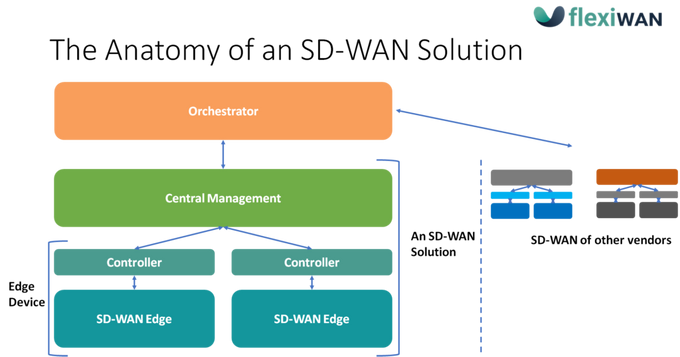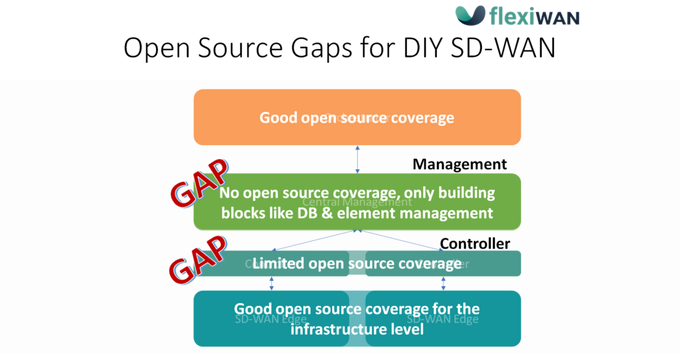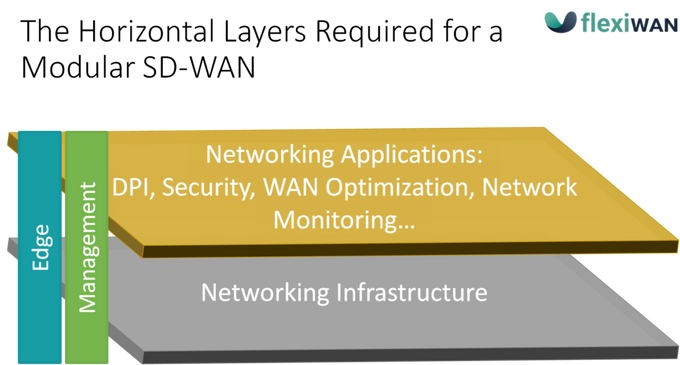What Are SD-WAN and Its Open-Source Building Blocks?
Discover how SD-WAN leverages open-source technologies to revolutionize networking solutions.
Updated May 9, 2024.

In this article
What Is SD-WAN?
Open Source Elements and Where They Fit in the SD-WAN Architecture
Breaking SD-WAN Horizontally Makes It an Open SD-WAN Architecture
What Is Modular SD-WAN?
Show More
In the rapidly evolving landscape of networking technology, Software-Defined Wide Area Network (SD-WAN) has emerged as a transformative solution, promising enhanced connectivity, flexibility, and cost efficiency for enterprises.
However, not all SD-WAN architectures are created equal. Let's delve into the world of modular and open SD-WAN architecture, unveiling how it can be a game-changer in reducing costs by a staggering 50% to 90%.
What Is SD-WAN?
WANs used to rely on physical hardware and complex configurations to connect geographically separate locations, which was expensive and inflexible. SD-WAN is a newer technology that relies more on software to allow for more centralized control and automation.
Put simply, SD-WAN does the following:
- Uses various connection types: Such as multi-protocol label switching (MPLS), broadband internet, and LTE to securely connect users to applications and resources, centralizing and simplifying management of the network.
- Optimizes traffic flow: SD-WAN routes traffic through the various connections based on real-time performance and defined policies, improving performance by ensuring each application gets the bandwidth and network quality it needs.
Why Is Typical SD-WAN Architecture So Expensive?
Traditional SD-WAN vendors create their products using a multitude of open-source building blocks. They combine these with third-party licensed software and custom-built technology in a black box architecture to lock customers in.
Some people believe that all one needs to build an SD-WAN solution is to glue a few open-source elements together, but this isn't true. These black box solutions can be costly as they often require you to pay for pre-packaged solutions with extra features you don't need. Not only is this expensive in and of itself, but it also generally increases the complexity of the system and requires more powerful and expensive hardware to operate smoothly.
How a Modular and Open SD-WAN Solution Saves Money
On the other hand, opting for a modular approach to SD-WAN allows for cost-saving customization. You only have to pay for the features you need, resulting in cheaper licensing that's tailored to what your networking solution requires and what your hardware can handle.
Open Source Elements and Where They Fit in the SD-WAN Architecture
An SD-WAN solution is typically divided into edge, split into a controller and router, and management, split into the SD-WAN management itself and the orchestrator. The orchestrator should be considered external to a specific SD-WAN solution because it should be able to manage more than one vendor’s product and interact with other services such as OSS/BSS.
Below, we'll review some of the open source components available today that can be used for building an SD-WAN service. Keep in mind that these are just examples and not an extensive list of every available element.
Pro tip: Before using any open-source element, it's essential to check:
- Who is behind it
- The last time it was updated
- The available licenses - what is the open source license and is a commercial available
Edge Device Software
On the edge device (which can be software-only or a physical device), we will have the Linux OS, virtualization technologies, and, in some cases, container SD-WAN frameworks. In addition, we will have an open-source router such as FD.io and typically also DPDK for better networking performance. To these base elements, we should add the components responsible for encryption, tunnel creation, and management.
These elements, which could be considered the networking infrastructure, are required for connecting one edge device to the other. The following layer will be the add-on technologies, or networking applications, that implement the more advanced SD-WAN capabilities such as DPI, WAN optimization, and security.
The controller that rides on top will handle the routing protocols via the FRR open source as well as the connectivity and communication with the central management. They'll also hold the policy received from the management so that, in the event that the router disconnects from the central management, it will be able to continue operations.
Although some open-source options can be included in the networking applications and controller layers, these layers will mainly be based on proprietary technology developed by the vendor or licensed from a third party.
Typically in SD-WAN solutions, these are all closed in that one black box offered by the vendor with no control or choice left for the service provider or enterprise. This fact is one of the main pain points for service providers today, lack of differentiation they can offer for their SD-WAN hosted services.
Management
The central management includes an infrastructure layer that will typically comprise NODE.js and databases as well as open-source components for microservices orchestration and installation scripts. The core logic of the management will typically be proprietary, as that’s where a lot of the vendor's secret sauce is.
The orchestration layer doesn't contain some open-source options, but those would be outside the scope of the vendor's pure SD-WAN solution.
Open Source Gaps
As described above, there is good open-source coverage for some of the layers, but this doesn’t mean that using these open-source building blocks will make it easy to take the DIY approach to building your own SD-WAN solution.
As illustrated below, there are still gaps—mainly in the edge software controller and management. These are the layers that include the specific secret sauce and logic of the SD-WAN solution and, therefore, can’t be standalone but rather need to be part of the complete SD-WAN solution.
flexiWAN closes these gaps by offering the world’s first completely open-source SD-WAN solution, with all this logic included in the package.
Breaking SD-WAN Horizontally Makes It an Open SD-WAN Architecture
When we look closer at the horizontal layers that span across edge and management inside the SD-WAN architecture, we find that, with the right design and interfaces, it is possible to allow for much more flexibility and control in an SD-WAN product and service.
The networking infrastructure layer is what makes it possible to create secure tunnels between the branches themselves and between them and the cloud, build the network in various topologies (full mesh, hub and spoke, and any combination of these), and manage it from one central location. This also requires the implementation of routing protocols and managing the complete lifecycle of the solution, including software upgrades, availability, and health checks.
The top layer is where flexibility and modularity should come into place. Since enterprise network requirements can’t be viewed as a one-size-fits-all, SD-WAN solutions shouldn’t be built as such. Unfortunately, most SD-WAN vendors still build their products as closed boxes that make flexibility and modularity impossible. In turn, this doesn’t allow an SD-WAN-hosted service to be tailored to the needs of a specific enterprise or segment.
What Is Modular SD-WAN?
A modular SD-WAN should be built in these layers and allow for the integration and replacement of the different networking applications that comprise the overall SD-WAN functionality. This allows for the tailoring of the SD-WAN service deployment at a specific enterprise to the enterprise’s technical and budget requirements, reducing TCO.
Many of today’s proprietary SD-WANs have a bloated software stack requiring a minimum of a 4-core CPU and 8gb of memory for the smallest edge component. Adopting the practices of a modular and open architecture will allow us to reduce hardware requirements for the smaller edge components as well as the software cost. Following these concepts can reduce TCO by 50% to 90%.
Moreover, we see cases in which an enterprise will have different technical and budget requirements for different branches. The requirements for a small branch are not the same as those of a large HQ office or private cloud.
flexiWAN's SD-WAN Architecture
flexiWAN's networking infrastructure layer comprises the routing infrastructure components that work together with the central management. We also have the application infrastructure, which provides the interface for integrating, managing, synchronizing, and provisioning the networking applications. These can run in both the edge device and the management to allow for holistic life cycle management of the system.
These applications that run in the edge are not VNFs but rather applications tightly integrated with the SD-WAN edge router software and are part of the data flow, making the integration extremely efficient.
Enhance Your Networking With flexiWAN's SD-WAN Architecture
There is a large variety of open-source networking technologies that can be used to build an SD-WAN solution, but there are gaps that need to be filled in, mainly in the logic parts and the more advanced networking capabilities.
It is also clear that the lack of modularity of SD-WAN products and closing all components in one black box results in more expensive solutions and SD-WAN services that lack differentiation. Welcome to the cookie-cutter SD-WAN solutions.
flexiWAN closes these gaps by offering a comprehensive, modular, open-source SD-WAN solution built in an open architecture. The combination of open source with modularity and interfaces for 3rd-party application integration is democratizing the networking industry. This allows for launching and deploying cost-effective, purpose-tailored SD-WAN solutions that reduce TCO and allow for service provider differentiation.












